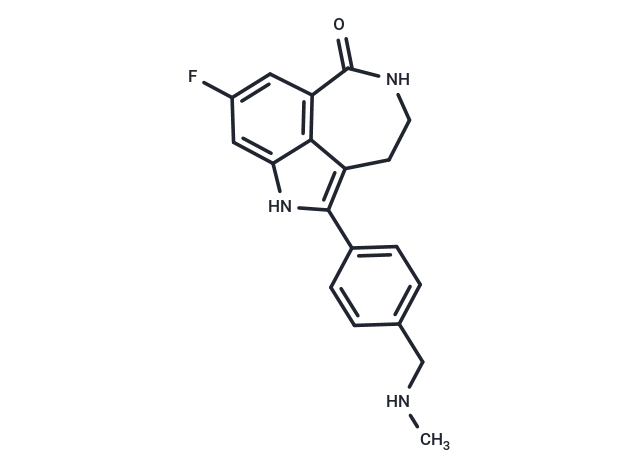Shopping Cart
- Remove All
 Your shopping cart is currently empty
Your shopping cart is currently empty

Rucaparib (PF-01367338) is a PARP protein inhibitor (PARP-1 Ki=1.4 nM) and hexose hexose-6-phosphate dehydrogenase (H6PD) inhibitor with oral activity. Rucaparib exhibits antitumor activity, with activity against desmoplasia-resistant prostate cancer (CRPC).

| Pack Size | Price | Availability | Quantity |
|---|---|---|---|
| 2 mg | $41 | In Stock | |
| 5 mg | $67 | In Stock | |
| 10 mg | $117 | In Stock | |
| 25 mg | $183 | In Stock | |
| 50 mg | $247 | In Stock | |
| 100 mg | $383 | In Stock | |
| 200 mg | $568 | In Stock | |
| 500 mg | $915 | In Stock | |
| 1 mL x 10 mM (in DMSO) | $74 | In Stock |
| Description | Rucaparib (PF-01367338) is a PARP protein inhibitor (PARP-1 Ki=1.4 nM) and hexose hexose-6-phosphate dehydrogenase (H6PD) inhibitor with oral activity. Rucaparib exhibits antitumor activity, with activity against desmoplasia-resistant prostate cancer (CRPC). |
| Targets&IC50 | PARP1:1.4 nM |
| In vitro | METHODS: Glioblastoma cell lines U251 and U87MG were treated with Rucaparib (0.2-100 µM) for 92 h. Cell viability was measured by MTT assay. RESULTS: Rucaparib inhibited the proliferation of GBM U251 and U87MG cancer cells in a dose-dependent manner with IC50 values of 14.36 µM and 15.00 µM, respectively.[1] METHODS: Human neuroblastoma cells SK-N-BE(2c) and human glioblastoma cells UVW/NAT were treated with Rucaparib (1-10 µM) for 1.5 h and then with H2O2 (20 mM) for 20 min, and the activity of PARP-1 was measured by Immunofluorescence. RESULTS: Rucaparib induced a 50% decrease in endogenous PARP-1 activity. treatment with the DNA damaging agent H2O2 resulted in a significant increase in PARP-1 activity, and the H2O2-induced increase in PARP-1 activity was reduced to a level comparable to that of the untreated cells after treatment with Rucaparib. [2] |
| In vivo | METHODS: To detect anti-tumor activity in vivo, BALB/C nude mice bearing U87MG xenografts were treated with Rucaparib (4 mg/kg, intraperitoneally) and BKM120 (15 mg/kg, orally) once daily for 16 days. RESULTS: Treatment with BKM120 or Rucaparib alone significantly inhibited tumor growth in terms of volume and weight. When used in combination, tumor growth was further inhibited compared to each drug alone. At the end of the 16-day treatment period, the combination therapy reduced tumor volume and tumor weight by more than 90%. [1] |
| Kinase Assay | Inhibition of PARP activity in 5×103 D283Med cells is measured using various concentrations of Rucaparib (0-1 μM), compared with DMSO-only. Maximally stimulated PARP activity is measured in samples of permeabilised cells by immunologica. |
| Cell Research | Medulloblastoma cell lines are seeded in 96-well plates at a density of 1×103, 3×103 and 3×103, respectively. At 24 hours (D384Med) or 48 hours (D283Med and D425Med) after seeding, the cells are exposed to various concentrations of temozolomide in the presence or absence of 0.4 μM Rucaparib. After 3 days (D425Med and D384Med) or 5 days (D283Med) of culture, cell viability is evaluated by a XTT cell proliferation kit assay. Cell growth is expressed as a percentage in relation to DMSO or 0.4 μM Rucaparib-alone controls. The concentration of temozolomide, alone or in combination with Rucaparib that inhibited growth by 50% (GI50) is calculated. The potentiation factor 50 (PF50) is defined as the ratio of the GI50 of temozolomide in the presence of Rucaparib to the GI50 of temozolomide alone. |
| Animal Research | Rucaparib is formulated in saline.A single dose of temozolomide is administrated p.o. as a suspension in saline at 200 mg/kg either alone or in combination with a single i.p. administration of PARP inhibitor administered at 0.1 [Rucaparib and MS-AG14644 (equivalent to 0.078 mg/kg free AG14644 only)], 1.0, and 10 mg/kg (for the mesylate salts equivalent to 0.79 and 7.9 mg/kg free AG14451 and AG14452 and 0.78 and 7.8 free AG14531 and AG14644). Control animals are treated with either normal saline p.o. and i.p or normal saline p.o and PARP inhibitor 10 mg/kg i.p. |
| Alias | PF-01367338, AG-14447, AG014699 |
| Molecular Weight | 323.36 |
| Formula | C19H18FN3O |
| Cas No. | 283173-50-2 |
| Smiles | O=C1C2=C3C(=C(NC3=CC(F)=C2)C4=CC=C(CNC)C=C4)CCN1 |
| Relative Density. | 1.281 g/cm3 |
| Storage | Powder: -20°C for 3 years | In solvent: -80°C for 1 year | Shipping with blue ice. | |||||||||||||||||||||||||||||||||||
| Solubility Information | DMSO: 32.5 mg/mL (100.51 mM), Sonication is recommended. | |||||||||||||||||||||||||||||||||||
Solution Preparation Table | ||||||||||||||||||||||||||||||||||||
DMSO
| ||||||||||||||||||||||||||||||||||||

Copyright © 2015-2025 TargetMol Chemicals Inc. All Rights Reserved.